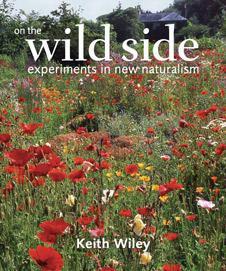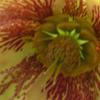 I was quietly excited to receive On the Wild Side by Keith Wiley to review. Whilst the book was originally published in 2004, Keith came to the UK’s gardening public’s attention when his new garden, Wild Side, was featured on the programme LandscapeMan. You only have to mention the chap who landscaped his garden with a digger truck and people know exactly who you mean.
I was quietly excited to receive On the Wild Side by Keith Wiley to review. Whilst the book was originally published in 2004, Keith came to the UK’s gardening public’s attention when his new garden, Wild Side, was featured on the programme LandscapeMan. You only have to mention the chap who landscaped his garden with a digger truck and people know exactly who you mean.
Keith’s approach is described as naturalistic and it is one which has interested me for a while. The book was written while Keith was still head gardener of The Garden House so before he had completely free reign of his new garden which featured in the programme which explains why some of the ideas seem to be only forming in Keith’s mind as he wrote the book.
I have to admit that my reaction to the book is very mixed. Keith starts by explaining his background and the early part of his horticultural career at the Garden House which had a very traditional garden. He got my attention when he starts to talk about his growing dissatisfaction with the gardens he was seeing, “if I came away with one different creative idea I would consider I had had a good day”. I can completely emphasise with this feeling. I have found myself increasingly walking around beautiful gardens but not feeling inspired. Keith talks about his growing feeling that part of the problem is the way we cultivate ornamental plants with intensive practices just as we do with vegetables, “the whole approach to soil management and plant feeding in ornamental gardening owes its origins to the historic practices involved in growing vegetables”. I couldn’t agree more. I personally feel that some of the instructions in ‘how to’ garden books are ridiculously prescriptive and gardeners should trust their instincts and give things a go. We should be looking at how plants grow in the wild in order to provide the best environment for them.
One of Keith’s overriding guiding principles to gardening is to ignore the idea that it is necessary to have all year round colour for every area of the garden. Instead he advocates colour for specific periods of the year in specific areas. This chimes with my thinking about my own garden exactly at the moment. He also describes his approach to using a wide range of colours in one border. Instead of having blocks of one plant against another and trying to avoid the colours jarring, if you mix the individual plants up you have an overall effect and the colours will work well. I find this fascinating but I suspect it is harder than it sounds to make it work well.
The book goes on to look at various native environments that Keith has visited around the world and how these have impacted on his horticultural, and in particular his planting, practice. I was very intrigued with his descriptions of creating a South African border through applying a thick layer of sand to the surface of a border as this replicates the conditions the plants from South Africa grow in. I’m not sure about the idea of replicating a native environment; for me this is heading towards a theme park approach.
Whilst I find the ideas in this book refreshing and thought-provoking I have found the book hard to read and follow. An example of one issue I had can be found in the chapter on shape and structure which wandered into mulches and was quite disjointed. I felt that Keith had so much to say on so many things that he was trying to cram all his ideas into one book rather than making it more succinct and more accessible. The other thing that irritated me, especially in the later chapters, was Keith pondering how different native plant combinations would work in a garden or worse still saying such and such would look nice with some perennials under it – all a little vague. I would much rather had read how he took this ideas and used them in the garden and see how they worked. It was all a little rambling in places.
However, Keith’s enthusiasm and passion shines through the pages and it was wonderful to read such liberating sentences as “One of the sublime beauties of this style is that there are no rules, with parameters being set only from the limitations of our own imaginations, experiences and memories…” I do hope that Keith is right and that “we stand on the edge of perhaps the most exciting period in gardening history for maybe the last hundred years.”

